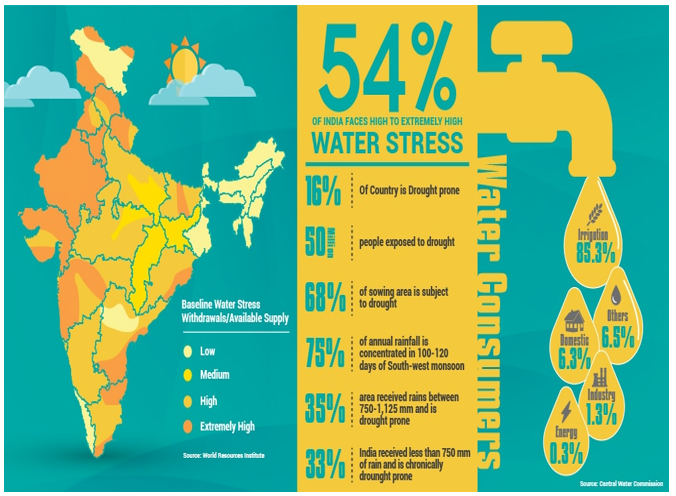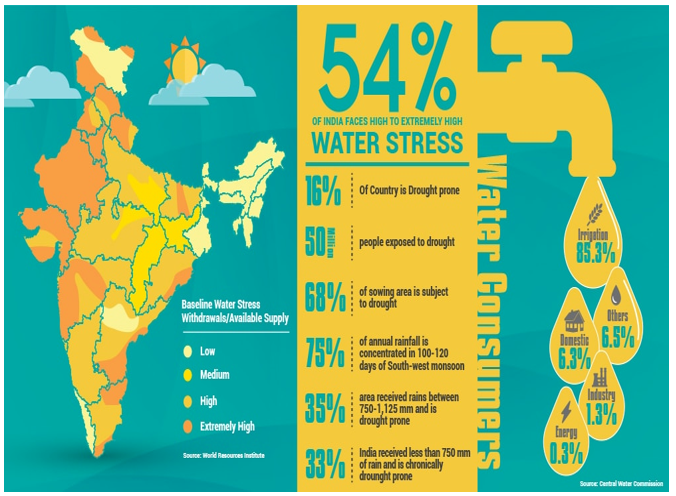- Courses
- GS Full Course 1 Year
- GS Full Course 2 Year
- GS Full Course 3 Year
- GS Full Course Till Selection
- CSAT
- 5 LAYERED ARJUNA Mentorship
- Public Administration Optional
- Online Program
- GS Recorded Course
- NCERT Batch
- Polity Module Course
- Geography Module Course
- Economy Module Course
- AMAC Module Course
- Modern India, Post Independence & World History Module Course
- Environment Module Course
- Governance Module Course
- Science & Tech. Module Course
- International Relations and Internal Security Module Course
- Disaster Management Module Course
- Ethics Module Course
- Essay Module Course
- Current Affairs Module Course
- ABOUT US
- OUR TOPPERS
- TEST SERIES
- FREE STUDY MATERIAL
- VIDEOS
- CONTACT US
Issue of High-Water Stress
Issue of High-Water Stress
29-08-2023

Latest Context:
As per the data released by World Resources Institute (WRI), almost 25 countries including India, face “extremely high water-stress” each year.
Key Findings are:
- Basically, a country facing “extreme water stress” means it is using at least 80% of its available supply, “high water stress” means it is withdrawing 40% of its supply.
- Around 50% of world’s entire population live under highly water-stressed conditions for at least one month of the year.
- Almost 30% of global GDP will be exposed to high water stress by 2050. The countries like India, Mexico, Egypt and Turkey will account for over half of exposed GDP in 2050.
- Approximately 60% of world’s irrigated agriculture faces extremely high-water stress.
What are the causes of global water stress?
- Population Growth: The world's population continues to grow, leading to increased demand of water for drinking, sanitation, agriculture, and industrial purposes. As more people compete for limited freshwater resources, water stress intensifies.
- Climate Change: Climate change is altering precipitation patterns and increasing the frequency and severity of droughts and floods. This variability in weather can disrupt water availability, making it difficult for regions to rely on predictable sources of freshwater.
- Water Pollution: Pollution from industrial, agricultural, and urban sources can contaminate water bodies, making them unsuitable for human use. Water pollution can also harm aquatic ecosystems and biodiversity, increasing water stress.
- Over-extraction: Over-extraction of groundwater and surface water for agriculture, industry, and municipal use can deplete aquifers and rivers faster than they can recharge naturally, leading to declining water tables and reduced river flows.
- Inefficient Water Use: Inefficient water use practices in agriculture, industry, and households can lead to wastage and contribute to water stress. This includes practices like flood irrigation, leaks in water distribution systems, and excessive water use for domestic purposes.
- Land Use Changes: Deforestation, urbanization, and changes in land use can alter natural hydrological cycles, reducing the capacity of landscapes to store and recharge water. This can lead to increased runoff and reduced groundwater recharge.
- Water Infrastructure: Poorly maintained or outdated water infrastructure can result in water losses through leaks and inefficiencies, further straining available water resources.
- Economic Development: Rapid economic growth and industrialization often increase water demand for manufacturing, energy production, and other sectors, contributing to water stress in regions where resources are already scarce.
- Political and Governance Issues: Water management and governance play a significant role in water stress. Disputes over transboundary water resources, corruption, lack of investment in infrastructure, and weak regulatory frameworks can increase water stress.
- Geographical Variation: Water stress is not evenly distributed globally. Some regions are naturally more arid and have less access to freshwater resources, while others may experience stress due to a combination of the factors mentioned above.

Initiatives taken by India to reduce water stress are:
- National Water Policy: India has a National Water Policy that emphasizes the sustainable and integrated development, management, and use of water resources. It promotes the conservation of water, efficient water use, and equitable distribution.
- River Basin Management: The government has implemented river basin management plans to promote integrated water resource management. For example, the Ganga River Basin Authority and the National Mission for Clean Ganga focus on cleaning and conserving the Ganges River.
- Rainwater Harvesting: Promoting rainwater harvesting techniques, especially in urban areas, is a priority. Rainwater harvesting systems are being encouraged for residential, commercial, and industrial buildings to recharge groundwater and reduce the burden on surface water sources.
- Water Use Efficiency: Improving water use efficiency in agriculture is a crucial step. The government has introduced programs such as the Pradhan Mantri Krishi Sinchayee Yojana (PMKSY) to modernize irrigation systems and promote efficient water use in agriculture.
- Wastewater Treatment: Initiatives to treat and reuse wastewater are being promoted to reduce pollution and improve the availability of water resources. The "Namami Gange" program aims to treat sewage and industrial effluents discharged into the Ganges River.
- Interlinking Rivers: The government has explored the possibility of interlinking rivers to transfer water from water-surplus regions to water-deficient regions. This is a highly debated and complex initiative.
- Groundwater Management: Promoting sustainable groundwater management is crucial in many parts of India. Programs like the National Aquifer Mapping and Management Program (NAQUIM) aim to map and manage groundwater resources.
- Crop Diversification: Encouraging farmers to shift from water-intensive crops to less water-intensive ones through incentives and education is a part of the strategy to reduce water use in agriculture.
- Community Participation: Many programs involve local communities in water management decisions to ensure sustainable use and equitable distribution.
- Research and Innovation: Investment in research and technology to develop innovative solutions for water management, such as water-saving irrigation techniques and drought-resistant crops.
Conclusion and way Forward:
India's efforts to reduce water stress are ongoing and require continued commitment, investment, and collaboration among various stakeholders, including government agencies, NGOs, and local communities. Water stress remains a significant challenge, and addressing it is essential for the country's sustainable development and the well-being of its people.
Must Check: IAS Coaching Centre In Delhi



